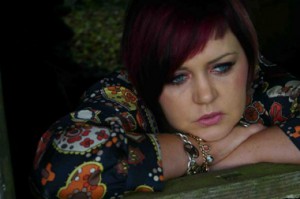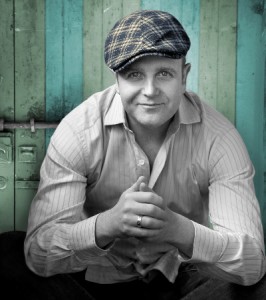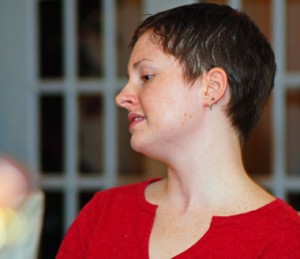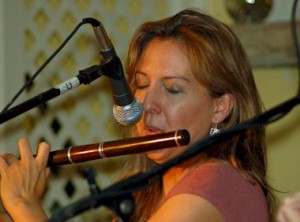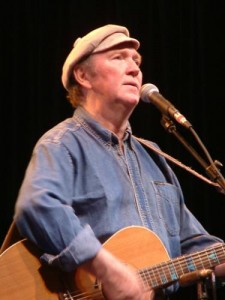
Liam Clancy at the Milwaukee Irish Fest. Photo courtesy of Sean Laffey, Irish Music Magazine
Liam Clancy, the last surviving member of The Clancy Brothers and Tommy Makem—possibly the best known of all the Irish folk groups—died on December 4 at the age of 74 in Cork, Ireland, of pulmonary fibrosis, a lung disease.
A celebrated balladeer—friend Bob Dylan called him the best he’d ever heard—Liam and older brothers, Paddy and Tom, a friend Tommy Makem appeared on the Ed Sullivan Show in March 1961, wearing their matching Aran sweaters (reportedly sent to them by the Clancys’ mother, Johanna), a performance that catapulted them to fame. By the following year, they had played Carnegie Hall and for President John F. Kennedy at the White House. The Clancys and Makem are widely credited with making traditional Irish music popular during the ‘60s folk revival both in the United States and in Ireland, and with influencing more than a generation of Irish musicians.
Liam Clancy was born on September 2, 1935, the youngest of 11 children in a musical family, in Carrick-on-Suir in County Tipperary. Along with music, the Clancy brothers loved acting. They immigated to the United States where they staged plays at the Cherry Lane Theatre in Greenwich Village, New York, raising money by holding midnight folk concerts after their productions. Liam even shared the stage with Walter Matthau and the young Robert Redford. Even though music called, Clancy always enjoyed reciting poetry as much as singing ballads.
We asked a number of Irish musicians and music lovers—some of whom knew Liam Clancy—to share their memories and their tributes with us. Here’s what they had to say:
Gerry Timlin, musician, Tyrone native, and co-owner of The Shanachie Irish Pub & Restaurant in Ambler
Liam Clancy, like his brothers and Tommy Makem, were my musical heroes, and like many a young folk music lover of the late 50’s and the early 60’s it was so refreshing to hear these new voices and songs coming from the wireless and records. The Clancy Brothers and Tommy Makem Live at Carnegie Hall is my favorite Irish album of all time. Liam Clancy’s versions of “The Patriot Game” and “The Parting Glass” will live on for ever, for me at least, as the best renditions of these two songs I’ve ever heard. Liam had a quality to his voice that was second to none and what struck me most was his diction and his unbelievable phrasing. The clarity of his voice was such that whether on not you’d heard the song before you could understand every word; his interpretation of songs and poems was impeccable. I know of no other singer, and I’ve worked with many, who could put a song across as well as Liam.
I had the pleasure of working with Liam on many occasions and I never knew him to be anything but the real deal when he stood under the lights. He was the consummate performer, the poet, the storyteller, the actor and the singer. He brought it all to the stage like no other performer I’d ever seen before in any genre. He knew his craft better than anyone and he loved his audience with a passion. He had that look in his eye and sincerity when singing a ballad that held you captivated and on the edge of your seat while he bought you to that place as only he could.
We have lost the last of a long line of great singers and entertainers. Tom, Paddy, Bobby, Tommy Makem and now Liam. The trailblazers who made the stage for all the rest of us. Now all gone. Who will carry the torch now? I’m not sure, but one thing is for sure—we’ll never see the likes of them again.
Onward and upward, Liam.
Paul Keating, director of the Catskills Irish Arts Week and a columnist for the Irish Voice newspaper
Liam Clancy described himself the last man standing among the Clancy Brothers and Tommy Makem, so amidst all the tributes to him are the declarations that it is the end of an era with them all gone now. I don’t share that view because what they did was release the great power of Irish music to the world and that can never be restrained now. They literally opened the doors for thousands of Irish musical artists including the Chieftains and inspired many careers and gave the Irish a confidence boost that predated the Celtic Tiger by thirty years. Liam Clancy continued to do that and encourage groups like Cherish the Ladies and Danu in the traditional realm for which he had great respect and appreciation for their talent.
A half century ago the Clancy Brothers and Tommy Makem were in the vanguard of the Greenwich Village Folk Music Boom that vied for attention with rock and roll and held their own. Even as he turned 70 some years ago, I was reminded when watching him at the Milwaukee Irish Fest that Liam Clancy still had magnetism and stage command. Celtic rock is the rage at most festivals these days and ironically its stage adjoined that of the Roots Stage where Liam’s solo act was slotted. With humor, poetry, prose and one of the greatest voices ever, Liam Clancy once again held his own that day, with a multigenerational crowd totally mesmerized by his charm and talent. His performance and many like it will never be forgotten by those who were fortunate to see him over the years and I am quite certain that I couldn’t say that about the other stage guests.
Sean Laffey, musician and editor of Irish Music Magazine
Liam was just the business, nobody ever like him, now then or in future, he just had it.
There is great sadness in the Laffey house today, but joy too that we got to know him personally and we had some time over our Saturday breakfast recalling the great times we had back in ’96 when we worked on his “Wild and Wasteful Ocean” album with him.
We had such fun in Helvic, singing into the rainy morning under an umbrella in front of Mooney’s pub, the table littered with pint bottles of stout and Liam egging me on to sing another verse and another verse of “Essequibo River,” which he really loved. Such generosity of spirit, the mark of a true gentleman.
Then there was a night in Dublin, at the Tall ships, when he and [nephew] Robbie O’Connell brought a dockside pub to life, the afternoon gig we had all done was by any standards mediocre, but that night’s music was beyond doubt special, and no one got it on tape or poked a camera phone in his face. It was singing for pleasure and right now it’s the best way I can think of
remembering him.
There will be much more written about Liam in the coming weeks, but for now we send our deepest condolences to his wife Kim and all his children. And thank God for the blessing that was Liam Clancy.
Judy Walsh, active on the Irish music scene in DC, now living in Milltown Malbay, County Clare
Years ago in Washington, DC, I was asked by a friend to chauffeur Liam and Tommy Makem to a concert he was putting on. I took them to The Dubliner Pub for an early supper. While we were eating, a man walked by, stopped suddenly and said to Liam, “I know who you are! Christy Moore! Can I have your autograph?” He grabbed a paper napkin from a nearby table and Liam signed it “Christy Moore”. Years later when I met Christy’s sister Anne here in Miltown Malbay she got a big kick out of the story, as did her brother when she told him.
Gabriel Donohue, Irish singer, musician, producer from Anthenry, County Galway, now of New Jersey
The first time I met Liam was in New York at Tramps Club in the village. I was playing with Eileen Ivers and Joanie Madden.We opened for him and when he walked in there was a very small crowd. He didn’t go on stage at all that night but got the small crowd to encircle him as he reigned over a world class session. Danny Quinn was there and Pat Kilbride (Battlefield band) also Martin Murray (Chieftains sound man and fiddler).
Liam was a very open individual who didn’t mind sharing his philosophy and his poetry to whomever would listen. He taught me more about Yeats, Shakespeare, Baudelaire and Tennyson than I ever learned in school. I went out and bought the poetry afterwards to get a little deeper, but he was the catalyst for me getting into those poets.
I was spellbound by his reading of Mary Hynes and suggested it to Joanie Madden for the CD I was then producing for her. I played piano on that track and he teased me about using a diminished chord on that which he thought was jarring and of course he was right. Those chords are rarely heard in traditional music or folk. Still he chose it for his collection Liam Clancy favorites. Needless to say I was delighted.
He and Paddy would often come to visit in New York city when I played at the South Street Seaport or Rosie O’Grady’s. Liam would sing a few songs and bring an otherwise indifferent audience to their senses. Afterwards we’d retreat to the Glocca Morrah on 23rd Street and more stories of Leadbelly or their tenure at the Playboy Club in Chicago would ensue.
They never took for granted the richness of their lives and the characters they met along their journey as evidenced by the stories they told over and over. I remember most of them. About passing a guitar around a circle in New York and singing songs but passing over this one young man all night. Finally Liam says “Do you sing at all? ” The young man says “a little” and sings a song he just wrote, “Mister Bojangles.” Jerry Jeff Walker was willing to sit silent and soak all the magic up in silent awe at the culture these Clancys carried with them.
Just this January I spent a week in Mexico with Liam and the Makem Brothers and a fine entourage of musicians. Liam was no longer willing to sit and recite poetry or sing songs until the dawn. Nevertheless, one night he called me over to a quiet corner in one of the lounges and began philosophizing on a few different topics. Words were the most precious thing to him. He said he loved them even more than music. He spoke of the closing scene of the movie, “The Night of the Iguana,” about a man at the end of his rope. I was saddened to hear him talk this way as he was as powerful performer as ever. Still I knew he was tired.
Thousands of performances had taken their toll as had the hardship of a less than ideal childhood in Carrick on Suir in Tipperary. His lungs were not able to power that godlike voice of his, though his shows were still brilliant. He was ready for a good long rest it seemed.
He was my hero, probably the greatest hero I ever had. A nice man too, who welcomed people into his circle with that great big Clancy heart that they all had. Their voices thundered out of our small record player we had back in Athenry with few discs except theirs to play on it. We learned of heroes like Roddy McCorley and the street songs like “Tell Me Ma” and “Finnegans Wake.”
Can we imagine a childhood without the sweater men? Inconceivable as a playground without the laughter of children.
Slán Liam and thanks for all you did for the music and us the purveyors of the ancient art of balladry.
Fil Campbell, Irish folk singer, of Rostrevor, County Down
I had the pleasure of meeting him on a couple of occasions at parties here in Rostrevor but sadly only as a passing acquaintance.
Liam had a huge influence on Irish music and on me personally—one of the first concerts I ever went to see was Liam Clancy and Tommy Makem as a duo in the Astoria Ballroom in Bundoran. I had been more into pop and rock music up until that time but they changed my focus—they sang so may songs that I knew and loved, songs that have stayed in my repertoire over the years. Ironically the guitarist who played with them that night was Brendan Emmett who now plays with Tom [McFarland, her husband and partner] and myself.
The Clancy brothers and Liam in particular had the flamboyance of superstars and an energy that made Irish music a force to be reckoned with on the world stage. They were fiercely proud of their heritage and the legacy of their recordings will be with us for a very long time to come. You’ll be sadly missed Liam—RIP.
Matt Keane, Irish singer, County Galway
I didnt know Liam, but without knowing it, he was the cause of me trying to learn to play guitar and sing. Sometime in the ‘60s, himself and Tommy came to play in my local town, Tuam, Co. Galway. He played and sang, “The Band Played Waltzing Matilda” to a spellbound audience in the Odeon Cinema. My sister Dolores [Keane] and brother Sean would have met Liam at various venues all over the place. I played Galway last night and sang ” Matilda” and “Will You Go Lassie Go.” All the audience joined in, which is an indication of the appreciation and respect in which he was held.
Carmel Gunning, composer and musician from County Sligo
I didn’t know Liam personally but I had great respect for his talent as a ballad singer and the way he put a song across to his audiences. He had a lovely sweet velvet voice, so easy on the ear and very tuneful. It’s the end of an era really. The group sang and jelled very well together simply because they knew each other so well and they were all equally as good as each other, be it on their instrument or voice. Rest in Peace.

